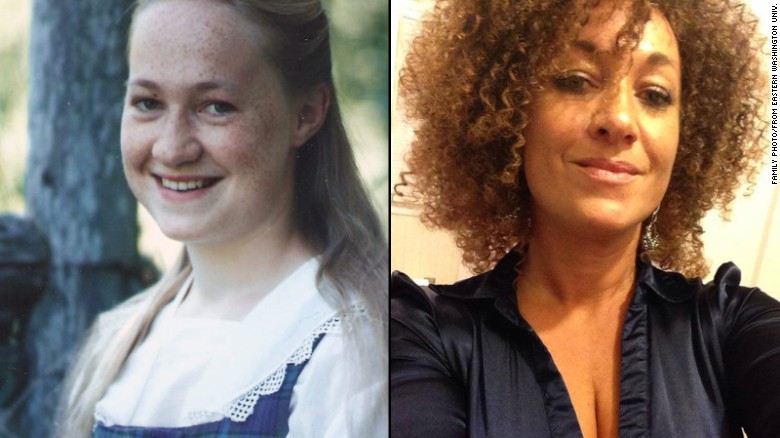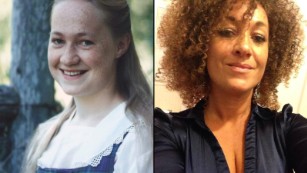MEMPHIS TN (IFS) -- The question comes up about "Black Face" and being the leader of the NAACP, an organization founded by Northern Whites in the 1800's and yes their first presidents of the movement were white. So we have here a question of who is white and who is black. Not one of us. . . When Senator John Kerry's wife, Terri Heinz told everyone at the Democratic Convention several years ago, that she was AFRICIAN-AMERICAN - no one said a word. The facts is that Mrs. Heinz-Kerry is African-American and white. She was born in South Africa and moved to America and is worth Billions of dollars. Yet no one questions her race.
I'm sure that if Ms. Dolezal would take a DNA test, it would reveal much more, and if she chooses too be an elephant, so be it, or even Kermit the green frog. I'm very happy that she is a pioneer since the days of John Howard Griffin's "Black Like Me" and wishes to experience her life. As for her attending Howard University. She never said that she was African-American or any other race, the school naturally assumed the position. It also appears that she has never deceived anyone about anything, it has been us to "assume" her identify, she merely acted on it.
Remember most of the actors in Hollywood are not whom they say they are, from names to appearances. So what's the beef. Let this brave citizen live her life. -KHS
Black Like Me is a nonfiction book by journalist
John Howard Griffin first published in
1961. Griffin was a
white native of
Dallas, Texas and the book describes his six-week experience travelling on
Greyhound buses (occasionally
hitchhiking) throughout the
racially segregated states of
Louisiana,
Mississippi,
Alabama, and
Georgia passing as a
black man.
Sepia Magazine financed the project in exchange for the right to print the account first as a series of articles.
Griffin kept a journal of his experiences; the 188-page diary was the genesis of the book.
At the time of the book's writing in 1959, race relations in America
were particularly strained and Griffin aimed to explain the difficulties
that
black people faced in certain areas. Under the care of a
doctor, Griffin artificially darkened his skin to pass as a black man.
In 1964, a film version of
Black Like Me starring
James Whitmore was produced.
Robert Bonazzi subsequently published the book
Man in the Mirror: John Howard Griffin and the Story of Black Like Me.
The title of the book is taken from the last line of the
Langston Hughes poem "Dream Variations".
Rachel Dolezal's appearance is 'blackface,' brother says
Story highlights
- Dolezal says she will likely speak Monday night at NAACP meeting
- In 2010, Dolezal became the legal guardian of her black adopted brother
- The Spokane NAACP head had identified partly as black; her parents say she is white
On that day
three years ago, he said, Rachel Dolezal, 37, told him she was starting
life anew in Spokane, Washington, where she's now head of the local
chapter of the NAACP and chairwoman of a police oversight committee.
Ezra
Dolezal, 22, came to visit her from Montana, where their parents live.
His adopted sister was on her way to becoming one of the most prominent
faces in Spokane's black community.
"She
told me not to blow her cover about the fact that she had this secret
life or alternate identity," Ezra Dolezal said Saturday. "She told me
not to tell anybody about Montana or her family over there. She said she
was starting a new life ... and this one person over there was actually
going to be her black father."
Dolezal's
race has come under question after her estranged mother claimed she is
white but is "being dishonest and deceptive with her identity."
Dolezal
has identified herself as at least partly African-American but her
Montana birth certificate states she was born to two parents who say
they are Caucasian. The parents shared that document and old photos with
CNN.
"I
kind of saw it coming," Ezra Dolezal said of the controversy. "Instead
of sticking to a simple story, she's been trying to make this really
complex and it finally got too big for her to handle."
CNN
contacted Dolezal on Saturday. She declined an on-camera interview,
saying she stands by her record of service and referring CNN to a
statement from the NAACP on Friday. Dolezal told CNN she would likely
speak Monday night at the NAACP meeting in Spokane
The
Spokane Spokesman-Review,
meanwhile, reported that she has framed the controversy surrounding her
racial identity in the context of litigation over guardianship of her
adopted brother.
"We are her birth
parents," Lawrence Dolezal told CNN on Friday. "We do not understand why
she feels it's necessary to misrepresent her ethnicity."
Rachel
Dolezal grew up in what her parents called a diverse family, with
friends from various ethnicities and four adopted siblings who are
black. She was "always interested in ethnicity and diversity" growing
up, her mother Ruthanne Dolezal said.
Dolezal
attended college in Mississippi, then went on to Howard University on
scholarship -- not having identified herself as black then on her
application because there was no such option, though people there may
have assumed as much "because her portfolio of art was all
African-American portraiture," her mother said.
It
wasn't until around 2007, her parents said, that Dolezal began
identifying herself more with the African-American community, according
to her mother.
Her parents say Rachel Dolezal "has chosen to distance herself from the family."
According
to court documents obtained by CNN, Rachel Dolezal's adopted brother,
Izaiah -- who is black -- sought emancipation from Ruthanne and Lawrence
Dolezal in 2010. The adopted brother, now 21, said the Dolezals used
"physical forms of punishment" and had sent his brother and sister away
to group homes because they didn't cooperate with the couple's religion
and rules.
'Slap in the face'
The
adopted brother wanted to live with Rachel Dolezal "in a multiracial
household where black culture is celebrated and I have a connection to
the black community," the court papers said. The papers did not specify
Rachel Dolezal's race.
Ezra Dolezal
said the accusations of physical punishment were false. They divided the
family. He said he never confronted his adopted sister when she asked
him not to blow her cover because he didn't want to make the situation
worse.
His adopted sister was always
interested in African-American culture but it wasn't until about 2011
that he started to notice physical changes.
"There was the gradual darkening of the skin and the hair," he said. "She started molding herself into who she is today."
He said Dolezal's transformation was tantamount to living in "blackface."
"It's
kind of a slap in the face to African-Americans because she doesn't
know what it's like to be black," said Ezra Dolezal, whose biological
mother was white and father half-black. "She's only been
African-American when it benefited her. She hasn't been through all the
struggles. She's only been African-American the last few years."
Izaiah's
petition for emancipation was dropped. In a separate legal action in
2010, the court appointed Rachel Dolezal to be the adopted brother's
guardian with the consent of Ruthanne and Lawrence Dolezal.
Ezra
Dolezal said he admires his adopted sister's appreciation and advocacy
for the black community and culture. But he questions her handling of
the race issue.
"I believe that the
first most important thing regardless of what a person does is that they
have integrity," he said. "Rachel has done really good work fighting
against racism and police brutality ... but she went about it the wrong
way. She said I was born black. I grew up black and I know what it's
like growing up as an African-American in this world. She does not."
Dolezal's
time at predominantly black Howard University may have been a major
turning point in her transformation, her adopted brother said.
"When
she applied they thought she was a black student," he said. "When she
came there, they saw she was white and she wasn't treated that well,
especially by people that worked there. She probably started developing
this kind of dislike for being white and dislike for white people. She
used to tell Izaiah ... that all white people are racists. She might
have developed some self-hatred."
On
Friday, the Dolezals told CNN they didn't want to comment on a possible
"legal dispute" that their daughter and the NAACP had mentioned.
One
organization that appears to be standing behind her is the NAACP. The
group, historically one of the most prominent in supporting causes
important to the African-American community, said that Dolezal is
"enduring a legal issue with her family" and that "we respect her
privacy in this matter."
"One's racial
identity is not a qualifying criteria or disqualifying standard for
NAACP leadership," the group said. "The NAACP Alaska-Oregon-Washington
State Conference stands behind Ms. Dolezal's advocacy record."
Challenged about her race
Dolezal
allegedly represented herself as African-American -- along with several
other ethnicities, including white and Native American -- in an
application for a Spokane police ombudsman commission.
And she has presented the public with
a different family photograph posted to the local NAACP chapter's Facebook page.
When she announced her father was coming to town for a visit, she
showed herself standing next to an older African-American man.
Dolezal's public racial identity came under scrutiny on Thursday, when a reporter from
CNN affiliate KXLY held up that photo and asked her if it showed her dad. She replied that it did.
Then came a follow-up question: "Are you African-American?"
"I
don't understand the question of -- I did tell you that, yes, that's my
dad. And he was unable to come in January," Dolezal responded.
"Are your parents -- are they white?" came the next query.
Dolezal walked away from the microphone, leaving her purse and keys, and took refuge in a nearby clothing boutique.
Expert, advocate on black community
Dolezal has built a wide-ranging career as an expert on and advocate for the black community.
She is not just president of her local NAACP chapter; she is also an academic expert on African-American culture and
teaches many related classes at Eastern Washington University.
She
represents the black community publicly and vocally, including as a
spokeswoman on race-influenced police violence. On Tuesday she spoke to
Al Jazeera on the topic. And Dolezal has appeared alongside Baltimore
City State's Attorney Marilyn Mosby, who has filed charges against
police officers in the death of Freddie Gray, a young black man.
The mayor of Spokane appointed Dolezal chairwoman of a police oversight committee to keep an eye on fairness in police work.
After
the allegations of faked racial identity surfaced, Mayor David Condon
and City Council President Ben Stuckart said they take "very seriously
the concerns raised regarding the chair of the independent citizen
police ombudsman commission."
The city is checking to see if she has violated any policies.
Still,
what Dolezal has done is more important than what race she is to the
NAACP, regional President Gerald Hankerson said. He called the NAACP a
civil rights organization first that includes "leaders from all
different ethnicities," adding that it "doesn't do a genealogy search on
what a person's ethnicity is when they" take a top position.
As
to Dolezal specifically, Hankerson said, "We represent all civil rights
issues, regardless of a person's ethnicity. And the quality of the work
that she has done to elevate the issues of civil rights in that region
is what we applaud."
CNN's Stephanie Elam, Paul Vercammen, Greg Botelho, Tony Marco and Ralph Ellis contributed to this






